The Benben Pyramid, often referred to as the Benben stone, is a significant artifact in ancient Egyptian mythology and religious symbolism. It represents the primordial mound upon which the god Atum stood at the beginning of creation. This pyramid-shaped stone is closely associated with the sun god Ra and the ancient city of Heliopolis, which was a major center for the worship of the sun deity.

The unique point of the Benben Pyramid lies in its shape and symbolic meaning. Unlike the large pyramids built as royal tombs, the Benben stone is typically a small, pyramid-shaped stone placed atop obelisks and within temple complexes. It symbolizes the first land that emerged from the chaotic waters of Nun, the primordial ocean, marking the beginning of creation in Egyptian cosmology. This shape later influenced the design of the capstones, or pyramidions, found on the tops of large pyramids and obelisks.
Historically, the Benben Pyramid holds profound religious and cultural significance. It embodies the concept of creation and the connection between the divine and the terrestrial. In temples, the Benben stone was a focal point of worship and offerings, believed to house the spiritual essence of the gods. Its association with Heliopolis, the “City of the Sun,” underscores its importance in the ancient Egyptian belief system, emphasizing the cycle of life, death, and rebirth.
